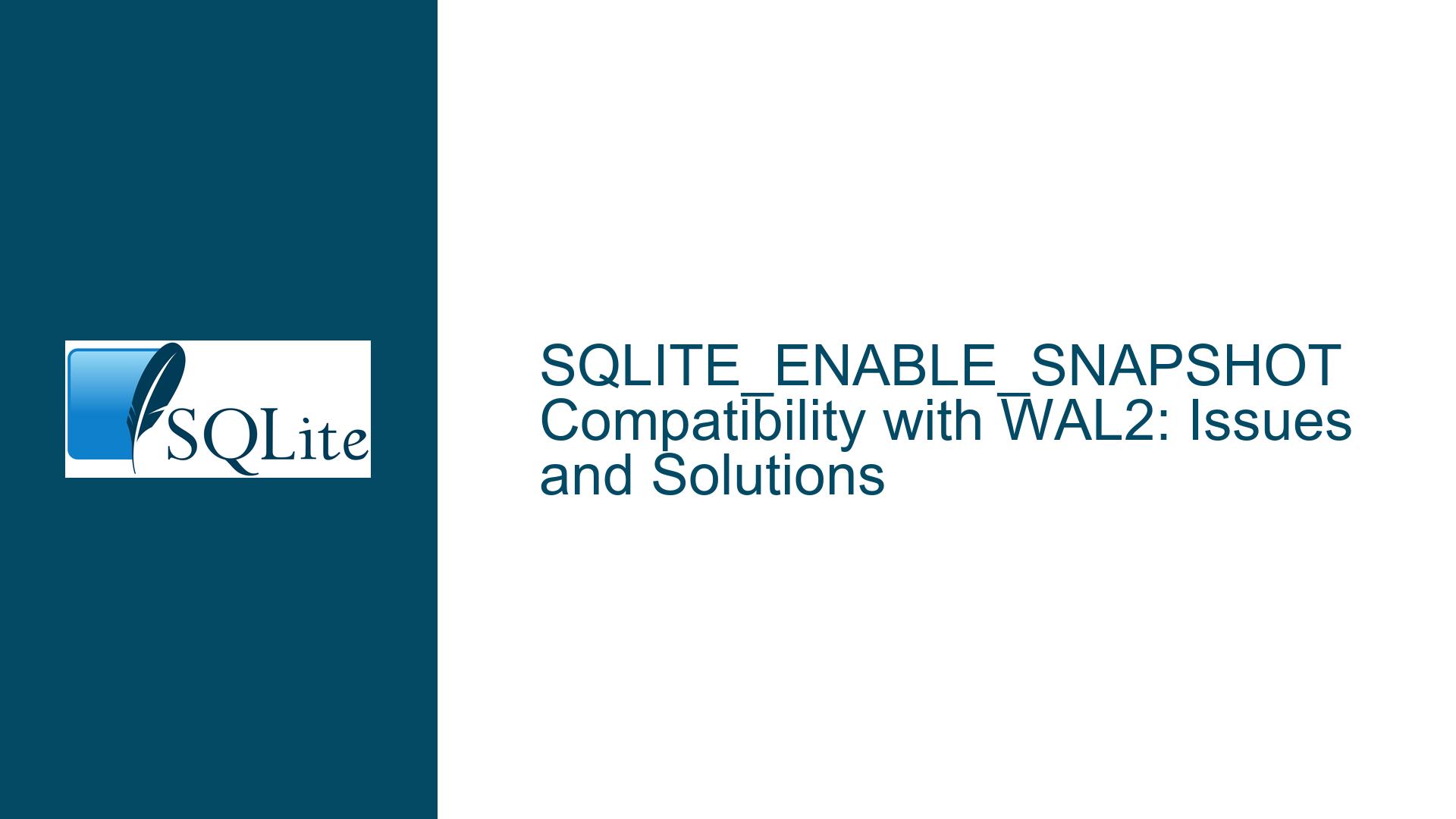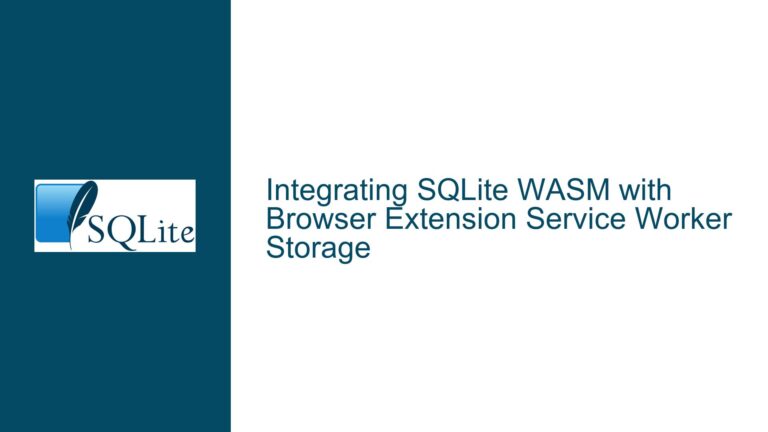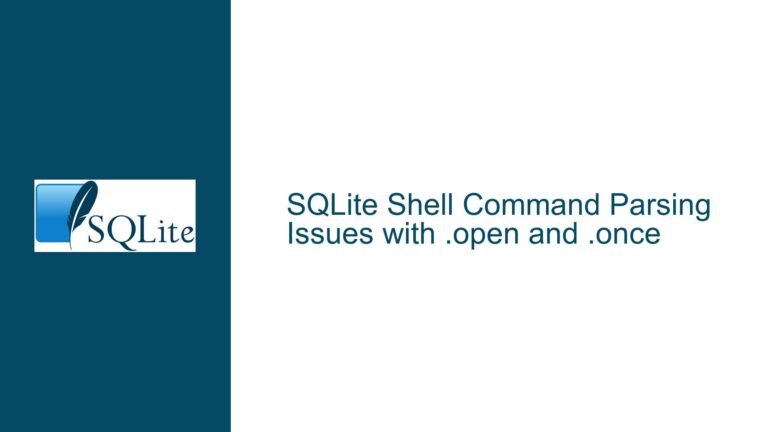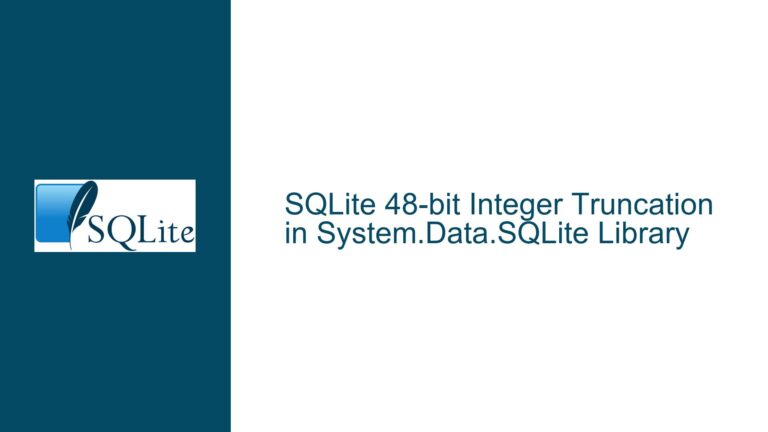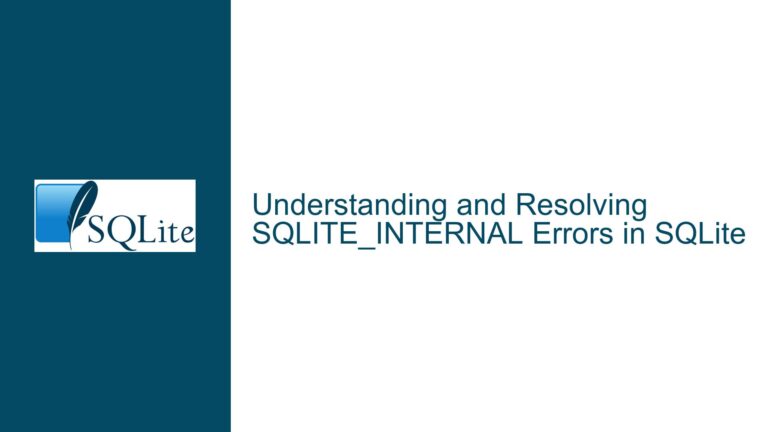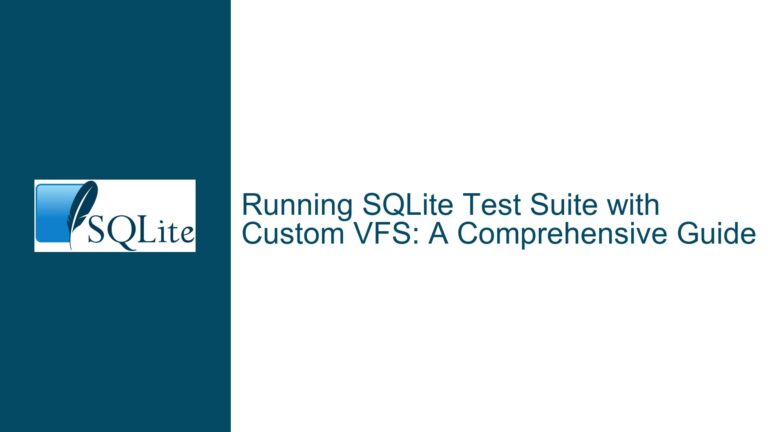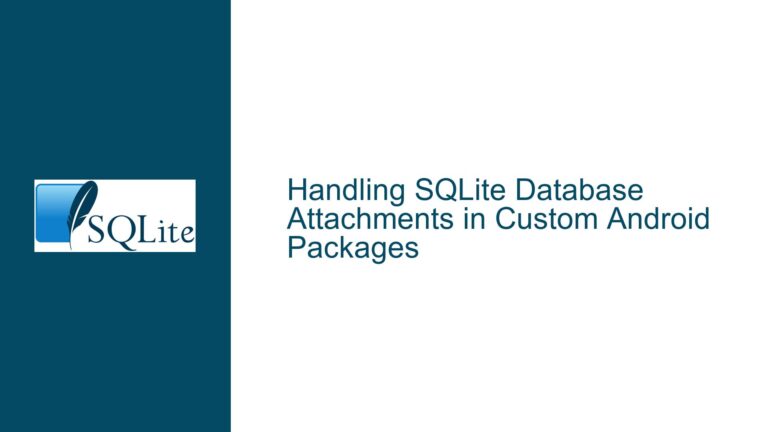SQLITE_ENABLE_SNAPSHOT Compatibility with WAL2: Issues and Solutions
Issue Overview: SQLITE_ENABLE_SNAPSHOT and WAL2 Integration Challenges
The core issue revolves around the compatibility and functionality of the SQLITE_ENABLE_SNAPSHOT feature when used with the WAL2 journaling mode in SQLite. The SQLITE_ENABLE_SNAPSHOT feature is designed to allow database connections to take a snapshot of the database at a specific point in time, enabling consistent reads without blocking writes. This is particularly useful in scenarios where long-running transactions or read-heavy workloads need to operate without interfering with write operations.
WAL2, on the other hand, is an experimental journaling mode that builds upon the original Write-Ahead Logging (WAL) mode. It introduces optimizations and enhancements aimed at improving performance and reducing contention in high-concurrency environments. However, the integration of SQLITE_ENABLE_SNAPSHOT with WAL2 is not straightforward, as evidenced by the reported issue where the feature fails to work as expected.
The primary challenge lies in the fact that the snapshot mechanism in SQLite is tightly coupled with the underlying journaling mode. The original WAL mode has well-defined behaviors and interfaces for managing snapshots, but WAL2, being a newer and less mature implementation, may not yet fully support these mechanisms. This discrepancy can lead to unexpected behavior, such as the snapshot feature not functioning correctly or causing instability in the database.
Furthermore, the provided patch suggests a potential workaround by modifying the vdbeaux.c file to include WAL2 in the list of journaling modes that are handled during the commit process. However, this patch is not a definitive solution and may not address all the underlying issues related to snapshot support in WAL2. The patch merely adds WAL2 to the list of journaling modes, but it does not ensure that the snapshot feature will work as intended.
In summary, the issue is multifaceted, involving both the technical limitations of WAL2 and the complexities of integrating the snapshot feature. The challenge is to identify the root causes of the incompatibility and develop a robust solution that ensures seamless operation of SQLITE_ENABLE_SNAPSHOT with WAL2.
Possible Causes: Why SQLITE_ENABLE_SNAPSHOT Fails with WAL2
The failure of SQLITE_ENABLE_SNAPSHOT to work with WAL2 can be attributed to several potential causes, each of which requires careful consideration and analysis. Understanding these causes is crucial for developing effective solutions and ensuring the stability and performance of the database.
1. Lack of Snapshot Support in WAL2 Implementation:
The most straightforward explanation is that WAL2, being an experimental journaling mode, may not yet fully support the snapshot feature. The original WAL mode has a well-established mechanism for managing snapshots, which involves maintaining a consistent view of the database by tracking changes in the WAL file. However, WAL2 introduces significant changes to the way the WAL file is managed, including optimizations for reducing contention and improving performance. These changes may not yet include the necessary infrastructure to support snapshots, leading to the observed failure.
2. Differences in Commit Handling Between WAL and WAL2:
The provided patch highlights a potential issue with the way commits are handled in WAL2 compared to WAL. In the original WAL mode, the commit process involves writing changes to the WAL file and then updating the database file. The snapshot feature relies on this process to ensure that a consistent view of the database is maintained. However, WAL2 may introduce changes to the commit process that are not compatible with the snapshot mechanism. For example, WAL2 might use a different approach to managing the WAL file, such as batching writes or using a different locking strategy, which could interfere with the snapshot feature.
3. Incomplete Integration of WAL2 with SQLite Core:
Another possible cause is that WAL2 is not yet fully integrated with the core components of SQLite that handle snapshots. The snapshot feature relies on several internal mechanisms, including the Pager, VDBE (Virtual Database Engine), and the WAL file management system. If WAL2 has not been fully integrated with these components, it may not be able to support the snapshot feature correctly. This could result in issues such as inconsistent snapshots, crashes, or other unexpected behavior.
4. Concurrency and Locking Issues:
WAL2 is designed to improve performance in high-concurrency environments by reducing contention and optimizing locking strategies. However, these optimizations may introduce new challenges when it comes to managing snapshots. For example, WAL2 might use more aggressive locking strategies that could interfere with the snapshot feature, leading to deadlocks or inconsistent reads. Additionally, the snapshot feature relies on precise coordination between multiple database connections, and any changes to the concurrency model in WAL2 could disrupt this coordination.
5. Testing and Validation Gaps:
Finally, it is possible that the integration of SQLITE_ENABLE_SNAPSHOT with WAL2 has not been thoroughly tested or validated. WAL2 is still an experimental feature, and it may not have been subjected to the same level of testing as the original WAL mode. This could result in undiscovered bugs or issues that only manifest under specific conditions, such as when the snapshot feature is enabled.
In conclusion, the failure of SQLITE_ENABLE_SNAPSHOT to work with WAL2 is likely due to a combination of factors, including incomplete support for snapshots in WAL2, differences in commit handling, incomplete integration with SQLite core components, concurrency and locking issues, and testing gaps. Addressing these issues will require a thorough analysis of the WAL2 implementation and its interaction with the snapshot feature, as well as careful testing and validation to ensure that the integration is robust and reliable.
Troubleshooting Steps, Solutions & Fixes: Ensuring SQLITE_ENABLE_SNAPSHOT Works with WAL2
To resolve the issue of SQLITE_ENABLE_SNAPSHOT not working with WAL2, a comprehensive approach is required. This involves identifying the root causes, implementing necessary changes, and validating the solution to ensure that the snapshot feature functions correctly with WAL2. Below are the detailed steps, solutions, and fixes to address the problem.
1. Analyze the WAL2 Implementation:
The first step is to thoroughly analyze the WAL2 implementation to understand how it differs from the original WAL mode, particularly in terms of snapshot support. This involves reviewing the source code, focusing on the components that handle snapshots, such as the Pager, VDBE, and WAL file management system. Special attention should be paid to the commit process, as this is where the snapshot mechanism is most likely to be affected.
Solution: Create a detailed comparison between the WAL and WAL2 implementations, highlighting the differences in how snapshots are managed. This will help identify any missing or incompatible components in WAL2 that need to be addressed.
2. Modify the Commit Handling for WAL2:
The provided patch suggests modifying the vdbeaux.c file to include WAL2 in the list of journaling modes that are handled during the commit process. However, this is only a partial solution and may not address all the underlying issues. A more comprehensive approach is needed to ensure that the commit process in WAL2 is fully compatible with the snapshot feature.
Solution: Extend the patch to include additional changes that ensure the commit process in WAL2 is handled in a way that supports snapshots. This may involve modifying the way the WAL file is managed, ensuring that changes are written in a manner that allows for consistent snapshots. Additionally, the patch should be tested extensively to ensure that it does not introduce new issues or regressions.
3. Integrate WAL2 with SQLite Core Components:
If the issue is due to incomplete integration of WAL2 with the core components of SQLite, such as the Pager and VDBE, then these components need to be updated to fully support WAL2. This may involve adding new interfaces or modifying existing ones to ensure that the snapshot feature works correctly with WAL2.
Solution: Review the integration points between WAL2 and the core SQLite components, and make any necessary changes to ensure that the snapshot feature is fully supported. This may involve adding new functions or modifying existing ones to handle the specific requirements of WAL2. Additionally, the changes should be tested to ensure that they do not introduce new issues or regressions.
4. Address Concurrency and Locking Issues:
If the issue is related to concurrency and locking, then the locking strategies used by WAL2 need to be reviewed and modified to ensure that they do not interfere with the snapshot feature. This may involve adding new locking mechanisms or modifying existing ones to ensure that snapshots can be taken consistently without causing deadlocks or inconsistent reads.
Solution: Analyze the locking strategies used by WAL2 and identify any potential issues that could interfere with the snapshot feature. Modify the locking strategies as needed to ensure that snapshots can be taken consistently and without causing deadlocks. Additionally, the changes should be tested to ensure that they do not introduce new issues or regressions.
5. Conduct Thorough Testing and Validation:
Finally, it is essential to conduct thorough testing and validation to ensure that the changes made to support SQLITE_ENABLE_SNAPSHOT with WAL2 are effective and do not introduce new issues. This includes testing the snapshot feature under various conditions, such as high-concurrency environments, long-running transactions, and different workloads.
Solution: Develop a comprehensive test plan that covers all aspects of the snapshot feature, including its interaction with WAL2. This should include unit tests, integration tests, and performance tests to ensure that the feature works correctly and does not introduce new issues. Additionally, the tests should be run under different conditions to ensure that the changes are robust and reliable.
6. Document the Changes and Provide Guidance:
Once the changes have been implemented and validated, it is important to document them and provide guidance on how to use the SQLITE_ENABLE_SNAPSHOT feature with WAL2. This includes updating the SQLite documentation, providing examples, and offering best practices for using the feature in different scenarios.
Solution: Update the SQLite documentation to include detailed information on how to use the SQLITE_ENABLE_SNAPSHOT feature with WAL2. Provide examples and best practices for using the feature in different scenarios, and ensure that the documentation is clear and easy to understand.
In conclusion, resolving the issue of SQLITE_ENABLE_SNAPSHOT not working with WAL2 requires a comprehensive approach that involves analyzing the WAL2 implementation, modifying the commit handling, integrating WAL2 with SQLite core components, addressing concurrency and locking issues, conducting thorough testing and validation, and documenting the changes. By following these steps, it is possible to ensure that the snapshot feature works correctly with WAL2, providing a robust and reliable solution for managing consistent reads in high-concurrency environments.
